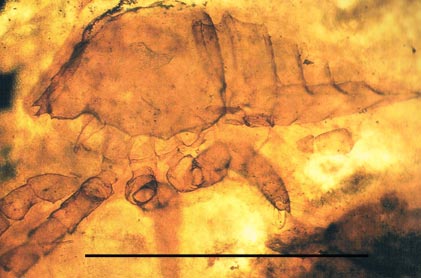410-Million-Year-Old Arachnid Walks Again
A team of international researchers have used fossils of ancient arthropods from the London Natural History Museum to recreate the movements of some of the world’s first terrestrial predators. Researchers from the Museum für Naturkunde (Berlin) and Manchester University have used an open source computer programme called Blender to model the walking motion of a 410-million-year-old ancient arachnid.
The video shows the most likely gait that this tiny prehistoric predator could achieve as it stalked across the Devonian landscape. The paper, which details this research has been published in a special edition of the academic publication the “Journal of Palaeontology”.
410-Million-Year-Old Arachnid
The scientists took minute slices of the fossils of these early arachnids and once the limb segments and their joints had been identified they worked out the range of limb motion possible. From these measurements and using comparisons with extant arachnids, the researchers modelled the walking action using the Blender software programme. In this way, a creature dead for over 410 million years could once again walk.
Dr Russell Garwood, (palaeontologist at Manchester University), stated:
“When it comes to early life on land, land before our ancestors came out of the sea, these early arachnids were top dog of the food chain. They are now extinct, but from about 300 to 400 million years ago, they seem to have been more widespread than spiders. Now we can use the tools of computer graphics to better understand and recreate how they might have moved – all from thin slivers of rock, showing the joints in their legs.”
Supplemental Data Video 2 – Palaeocharinus Locomotion
Video credit: University of Manchester Press Room
Palaeocharinus Genus
The video shows the ancient arthropod (Palaeocharinus genus) walking. Although a formidable looking animal, this early creepy-crawly was less than half a centimetre in length. The fossils used in this study came from the famous Lower Devonian strata at Rhynie (Aberdeenshire, Scotland). The Rhynie chert deposit contains evidence of one of the earliest terrestrial ecosystems known to science. More than twenty primitive plant species have been identified along with arthropods such as mites and trigonotarbids such as Palaeocharinus that hunted amongst the miniature forest made up of Rhyniophytes (primitive plants).
Co-author of the scientific paper, Jason Dunlop (Museum für Naturkunde), added:
“These fossils, from a rock called Rhynie chert, are unusually well-preserved. During my PhD I could build up a pretty good idea of their appearance in life. This new study has gone further and shows us how they probably walked. For me, what’s really exciting is that scientists can make these animations now, without needing the technical wizardry and immense costs of a Jurassic Park-style film.”
Although not true spiders, trigonotarbids are related to modern spiders but they lack certain spider features such as silk producing spinnerets. As a group, they first appear in the fossil record in the Late Silurian. The oldest trigonotarbid specimen, that we at Everything Dinosaur know about, comes from the Upper Silurian deposits of Ludow , Shropshire (Ludlow epoch around 420 million years ago). It was Jason Dunlop who was responsible for describing this discovery (1996).
A Highly Magnified Image of a trigonotarbid (Palaeocharinus)
The scale bar in the picture represents 2 mm.
Dr Dunlop stated:
“When I started working on fossil arachnids we were happy if we could manage a sketch of what they used to look like, now we can view them running across our computer screens.”
The development of sophisticated computer programmes is permitting scientists to re-create three-dimensional images of spectacular fossils. In addition, new generation programming technology is now capable of bringing long extinct creatures back to life, at least in cyberspace. The predatory Palaeocharinus might be quite frightening, but at half a centimetre long it would probably not even had got a second glance if you spotted on in the garden.
However, other specimens from Upper Devonian strata, as yet not fully described fossils, indicate that there were much larger creatures at home amongst the primitive plants such as the Rhyniophytes and Lycopsids (clubmosses), some fossils indicate arthropods nearly an inch in length. These creatures may not be trigonotarbids but perhaps represent an entirely new family of Arthropoda.
Dr Garwood concluded:
“Using open source software means that this is something anyone could do at home, while allowing us to understand these early land animals better than ever before.”
Everything Dinosaur acknowledges the help of the Faculty of Engineering and Sciences (University of Manchester) in the compilation of this article.







Leave A Comment